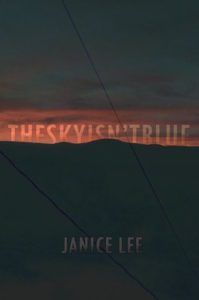
In The Sky Isn’t Blue, Janice Lee inhabits physical and temporal spaces, moments, memories, and dimensions that exist between and amongst language. She moves through experiences almost as if she has been caught off guard by her own being, as if she is suddenly looking at herself, becoming herself, for the first time. Lee narrates our own consciousness, framing our desires, examining our relationships, and questioning our assumptions. In this collection of essays that narrate the poetics of spaces, language remains the most problematic, haunting, beautiful specter of all.
In her essay “The Suspension of the Imaginary in the Real,” Lee writes, “The blue is a signifier of distance, of desire, of longing. The sky is blue because we want it to be blue, and because it is blue it is very far away, and because it is far away, impossibly so, we want it more.” Throughout the collection there is the omnipresent feeling of longing and an inability to express or even know what is longed for, or why. Love and repulsion exist simultaneously—as Lee discusses, humans tend toward polemical extremes. Lee makes an insistent plea for a middle ground, the only place where empathy is possible. In this muddled space, the acceptance of the unnamed and the unknown—enlightenment—can occur. And yet we are human. We cannot be quite comfortable here. We are left with ghosts—as Lee writes in her essay “Los Angeles”, the inability to express what you want becomes the ghost or wound of what you want to say. “Like: I love you.” The desire for something unattainable persists around and within the words. The mundane blends with the surreal.
The longing that haunts us is related to the repetition, internalization, and constant dissipation of memories. Lee expresses the specific temporality of memory, how it is tied intimately to both time and place. In “Ocean Beach Pier,” she writes:
Ocean Beach Pier at night, recalls a certain image. I always remember one particular night when it was red tide and so the incoming tides and subtle movements of the water revealed a strange and eerie glow, the small but numerous bioluminescent dinoflagellates causing the water to glow blue. The same night the pier was full of people fishing, different colored glow sticks tied to the ends of their lines for visibility. And amidst the already eerie symphony of light and darkness, the fireworks from Sea World started to go off. I’m somewhere else, I thought. It was utterly chaotic: all of the different lights and people and flopping fish and voices and boom boxes, and it was utterly beautiful and calm: the darkness, the glow, the perfect home for ghosts and their sorrow.
And yet despite its importance, temporality is futile. Lee confesses that that night at Ocean Beach Pier only has significance in her own imagination. When she brings another person to this special place for the first time, when she visits this site in other temporal spaces, perhaps the memory shifts. Now she wonders what that person hears, what that person is thinking about. Perhaps this becomes a new memory. Memories fold and collapse on each other in another inarticulable realm that makes us, as humans, uncomfortable.
Lee discusses the discomfort of allowing one’s memories and identity to shift, to morph. She admits to a constant feeling of hesitation: “The question of what next. The question of releasing the ghost of oneself to face another.”
Memory is changing and fragmentary by nature. In “San Francisco” Lee writes:
…and what binds me to this city today, is not the nostalgia, nor even my mother’s ashes, but you, here, with me now, driving up and down these streets, the awaited conjuration that depends not on the past but a contingent present and future with someone who has become my entire world.
The world moves forward on an endless trajectory toward death, and although we are unable to translate what is happening, unable to truly own anything at all, we hold on. To words. To the blue of the sky. To another’s chest, in the night. Like humans do.
Lee frequently returns to the concept of death throughout her essays, whether she is confronting the ghost of her mother or reflecting on the satisfying crunch of fish bones under her feet in “The Salton Sea”. Our inability to express or define the boundary between the living and the dead belies a greater issue: our inability to know if such a boundary exists. The dead are part of the living: in longing, in memory. Lee writes, “Survival is an obscene gesture. An unnecessary one. No one has to live.” And yet: “In waiting for death, you agree to keep living.” We are wounded, we are haunted, we haunt. We suffer tremendously, necessarily. We don’t know if we invite others into our physical spaces, or if they invite themselves. We persist. The infinite universe continues whether we do or not, so what does it really matter, in the end? But somehow it does.
The Sky Isn’t Blue is a beautiful navigation of the discordant pluralities that make up the human experience and our attempts to move in and around what we cannot know or express. As Lee discusses, it is futile to attempt to assemble vast spaces into anything cohesive. And yet despite the failures of language, here we are. Lee writes poignantly, and perhaps reflexively, “Indeed, all narratives are about deterioration but we make them stories about conquest and growth and vitality.” The sky isn’t blue, but we are human, and we hold tightly to this wound.





